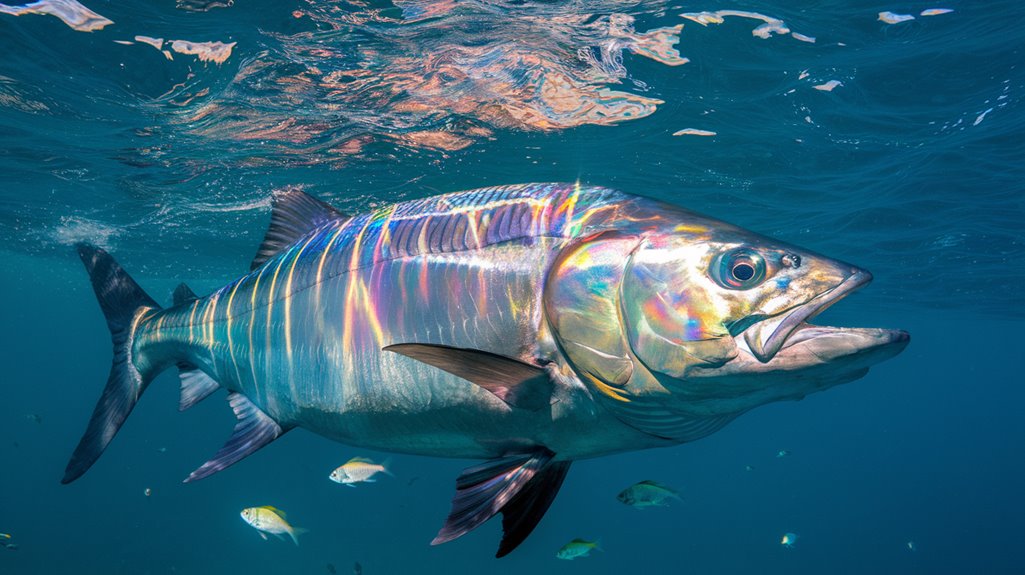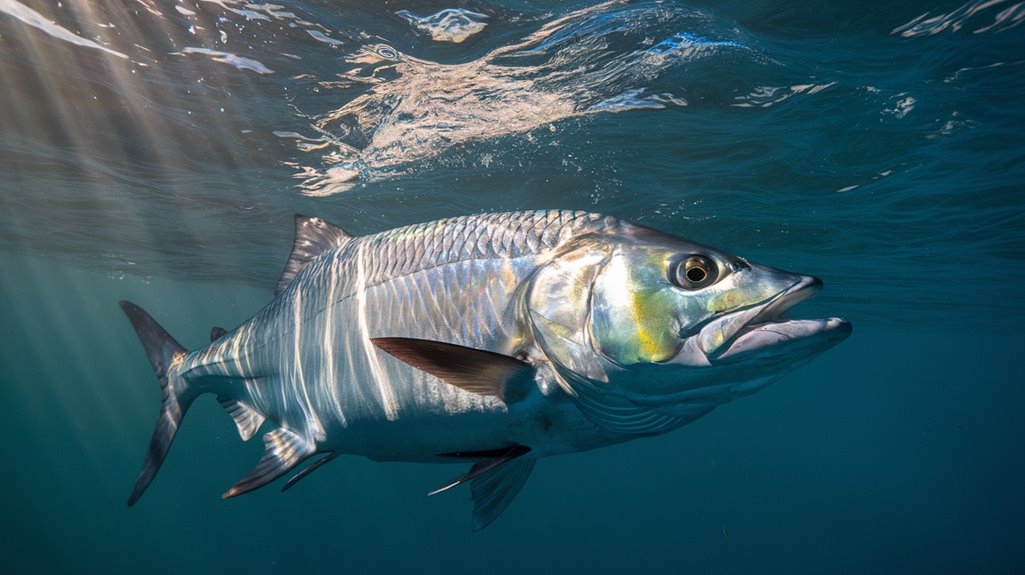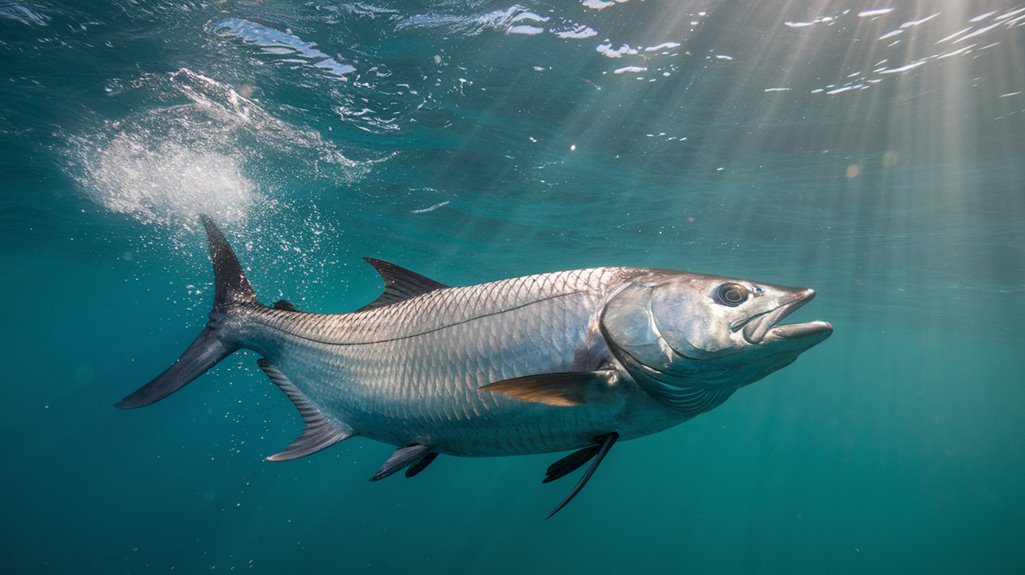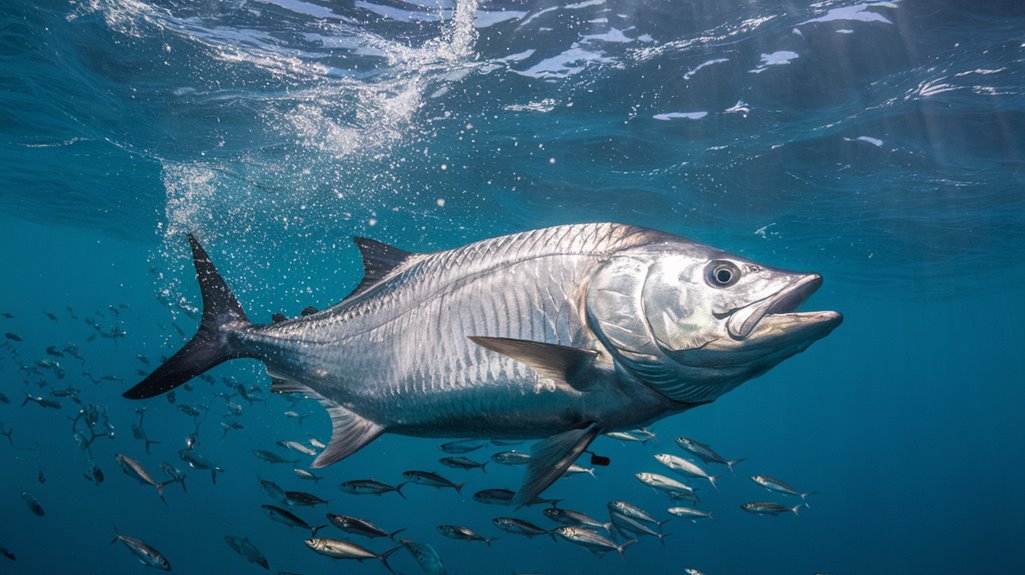You'll find tarpon photography presents a unique intersection of technical skill and marine awareness. As you track these magnificent fish through mangrove-lined waters, you'll need to master both your camera's capabilities and the art of prediction. Their mirror-like scales reflect light in ways that can challenge even seasoned photographers, while their swift movements demand split-second timing. Understanding how to capture these "silver kings" in their domain opens up possibilities that few aquatic subjects can match.
- Key Takeaways
- The Natural Habitat of Silver Kings
- Essential Camera Gear for Tarpon Photography
- Mastering Light and Shadow Underwater
- Techniques for Tracking Fast-Moving Tarpon
- Understanding Tarpon Behavior Patterns
- Best Times and Locations for Tarpon Shots
- Managing Visibility Challenges in Cave Settings
- Strobe Positioning and Power Settings
- The Art of Composition With Schooling Fish
- Post-Processing Tips for Underwater Images
- Frequently Asked Questions
- Conclusion
Key Takeaways
- Use a Nikon D200 with 10.5mm fisheye lens and Subtronic Strobes at ISO 200, 1/60th shutter speed, and f8 aperture.
- Time photography sessions during dawn and dusk when tarpon are most active and feeding in schools.
- Position strobes at full extension with quarter power to minimize backscatter and prevent overexposure of tarpon's reflective scales.
- Capture dynamic movements by utilizing continuous autofocus and maintaining fast shutter speeds while tracking schooling patterns.
- Frame compositions using natural elements like ocean floor contours and leading lines created by schooling tarpon behavior.
The Natural Habitat of Silver Kings

Three distinct ecosystems form the primary habitat of the majestic tarpon: mangroves, estuaries, and nearshore reefs. When you jump in the water, you'll discover these silver giants thriving in the warm coastal waters of regions like Belize and the Caribbean. You'll often spot them swimming in schools, particularly during their feeding periods, as they hunt for smaller fish and crustaceans among the protective roots of mangroves and coral formations.
These interconnected environments provide fundamental shelter and nourishment for tarpon populations, supporting their growth to impressive lengths of up to 8 feet. However, these critical habitats face mounting pressures from human activities, including pollution and coastal development. Understanding and preserving these ecosystems is essential for ensuring the continued survival of these magnificent fish.
Essential Camera Gear for Tarpon Photography
Capturing the silvery spectacle of tarpon demands specialized underwater photography equipment that can withstand challenging marine conditions. You'll need a reliable underwater camera like the Nikon D200, paired with a 10.5mm fisheye lens to maximize your field of view as these magnificent fish dart through the water.
To combat murky conditions, you'll want to equip your setup with Subtronic Strobes positioned at full extension from the housing. Set them to quarter power to prevent overexposure of the tarpon's reflective scales. For ideal exposure, configure your camera settings to ISO 200, with a shutter speed of 1/60th second and an aperture of f8. This combination provides the perfect balance between light management and image clarity, ensuring you'll capture every detail of these remarkable creatures in their natural environment.
Mastering Light and Shadow Underwater

While tarpon's reflective scales present unique challenges underwater, mastering light control becomes your primary focus for successful shots. You'll need to carefully manage your strobe power to prevent whiteout effects from their mirror-like surfaces. Position your strobes away from the camera housing to minimize backscatter in low visibility conditions, especially when working in environments like Belize's Silver Caves.
Enable your camera's highlight playback feature to quickly assess exposure levels and avoid blown-out images. You'll need to react swiftly as tarpon can emerge suddenly in varying light conditions. The key is finding the perfect balance between illumination and shadow – too much power will create harsh reflections, while too little won't reveal the fish's stunning details. Practice adjusting your strobe settings until it becomes second nature.
Techniques for Tracking Fast-Moving Tarpon
To capture tarpon's swift movements, you'll need to dial in fast shutter speeds of 1/60th or higher while maintaining continuous autofocus mode for tracking precision. Position yourself strategically by studying the tarpon's feeding patterns, allowing you to anticipate their trajectories and secure the best shooting angles. Your technical setup should include wide-angle lenses and carefully powered strobes to illuminate these magnificent fish without creating excessive reflection or washout in the challenging underwater environment.
Camera Settings For Speed
Fast-moving tarpon demand precise camera settings to freeze their dynamic movements underwater. You'll need to configure your camera for ideal performance in challenging aquatic conditions. Set your shutter speed to at least 1/250th of a second to eliminate motion blur while tracking these swift swimmers. Switch to continuous autofocus mode to maintain sharp focus as the tarpon moves through your frame.
- Select a wide aperture (f/4 or lower) to create subject separation from the background
- Increase ISO settings to 800 or higher for better low-light performance
- Enable burst mode to capture multiple frames in rapid succession
- Pre-focus on anticipated tarpon paths to improve hit rate
- Use continuous AF-C mode to track moving subjects effectively
These technical adjustments will greatly improve your success rate when photographing these magnificent fish in their natural habitat.
Positioning And Light Control
Successful tarpon photography requires mastering both camera settings and strategic positioning in the water. You'll need to maintain a low profile and use slow, deliberate movements to avoid startling these swift swimmers. When tracking tarpon, anticipate their path while staying aware of your surroundings.
For ideal light control, extend your strobes fully from the camera housing to minimize backscatter in particle-rich waters. Set your strobes to quarter power to prevent overexposing the tarpon's reflective scales. A 10.5mm fish eye lens will help you capture the action in tight spaces, especially when tarpon make unexpected moves in cave-like environments. Monitor your highlights during playback to guarantee proper exposure levels, keeping the details crisp without washing out the image's bright areas.
Anticipating Tarpon Movement Patterns
When photographing tarpon in their natural habitat, you'll need to develop an acute understanding of their behavioral patterns and environmental preferences. Watch for signs of feeding activity and schooling behavior while monitoring underwater currents and baitfish presence. You'll improve your success rate by implementing drift diving techniques and maintaining minimal disturbance as you track these powerful fish through coastal waters and estuaries.
- Monitor feeding patterns and school formations to predict movement
- Track underwater currents and baitfish concentrations
- Use drift diving techniques to minimize disturbance
- Position yourself within typical depth ranges where tarpon frequent
- Optimize your camera's autofocus and burst settings for quick responses
Understanding Tarpon Behavior Patterns
To capture stunning underwater photographs of tarpon, you'll need to master their distinctive behavioral patterns. They're most active during dawn and dusk when hunting silversides and crustaceans, offering prime opportunities for dynamic shots. You'll find them schooling together, especially during feeding times, which creates compelling compositional possibilities.
Watch for their acrobatic displays, as they'll often leap from the water when stressed or evading predators. Understanding their sensitivity to environmental conditions is essential – they'll migrate based on water temperature and salinity changes. You can optimize your shooting sessions by monitoring light conditions, as tarpon tend to be more visible and active in brighter settings. Position yourself strategically near their feeding grounds, where their natural hunting behaviors will provide the most engaging photographic moments.
Best Times and Locations for Tarpon Shots

Planning your tarpon photography expeditions during peak migration seasons, from April through July, will yield the most spectacular shooting opportunities. You'll find ideal conditions in renowned locations like the Florida Keys and Boca Grande, where clear waters and abundant schools create perfect settings for dramatic shots. Schedule your shoots during early morning or late afternoon hours to maximize the soft lighting conditions that enhance underwater visibility and accentuate the tarpon's distinctive silvery scales.
- Choose marine reserves with minimal boat traffic for undisturbed shooting conditions
- Position yourself in the Caribbean waters of Belize and Cayman Islands during peak migrations
- Equip yourself with fish-eye lenses for capturing wide-angle movement shots
- Select locations with exceptional water clarity for crystal-clear imagery
- Time your shoots during golden hours when light penetration is ideal
Managing Visibility Challenges in Cave Settings
When photographing tarpon in cave environments, you'll need to carefully manage suspended sediment by timing your shots between other photographers' movements and maintaining proper positioning to avoid stirring up sand yourself. Your strobe placement becomes critical – extend them wide from your housing while reducing power to prevent backscatter from the particulate matter in the water column. You can further enhance visibility by adopting a patient approach, allowing disturbed sediment to settle between shots, and adjusting your camera settings to compensate for the challenging light conditions.
Dealing With Suspended Sediment
Although suspended sediment presents considerable challenges for underwater photographers in cave settings, you'll need to master specific techniques to capture clear shots of tarpon in these environments. Managing suspended particles requires patience and strategic timing, combined with proper lighting techniques to minimize visibility issues. You'll find that extending your strobes away from the housing considerably reduces backscatter, while using reduced strobe power helps control reflections from the tarpon's silvery surfaces.
- Time your dives during periods of minimal disturbance to allow sediment to settle
- Practice manual focusing skills as autofocus systems often struggle in low-light cave conditions
- Monitor your camera's playback to prevent highlight overexposure
- Position strobes at maximum extension to reduce backscatter effects
- Adjust strobe power settings to manage reflective surfaces of tarpon
Strobe Positioning For Clarity
Proper strobe positioning stands as the cornerstone of successful tarpon photography in cave environments. You'll need to fully extend your strobes away from the housing to minimize backscatter from suspended particles, which can otherwise cloud your images. This technique becomes especially essential in Silver Caves' low-light conditions.
Set your strobes to quarter power to prevent overexposure of the tarpon's reflective scales. When you're working with ISO 200, a 1/60th second shutter speed, and f8 aperture, this reduced power setting helps maintain vital highlight detail. Position your strobes strategically to capture the tarpon's swift feeding movements while maintaining ideal visibility. Keep an eye on your camera's playback to check highlight retention, adjusting strobe placement and power as needed for clear, well-exposed shots.
Strobe Positioning and Power Settings
Successful underwater photography of tarpon demands meticulous attention to strobe positioning and power control. You'll need to keep your strobes fully extended from the camera housing while adjusting their power settings to achieve the best exposure. When shooting tarpon's reflective scales, reduce your strobe power to quarter strength to prevent whiteout effects and maintain detail. Working with ISO 200 and f8 helps you balance ambient light with strobe output, especially in challenging visibility conditions.
- Position strobes at different angles to create dynamic lighting effects
- Monitor your camera's playback to check highlight retention
- Keep strobes extended to minimize backscatter
- Adjust power settings based on the tarpon's reflective properties
- Balance strobe output with ambient light for natural-looking results
The Art of Composition With Schooling Fish
You'll find that schooling tarpon naturally create powerful leading lines as they move through the water, offering dynamic paths that draw viewers' eyes through your frame. The geometric patterns formed by these silver-sided fish can range from perfect circles to sweeping arcs, presenting striking compositional opportunities you can leverage for maximum visual impact. When you position yourself at the right angle, these formations will transform into compelling shapes that add depth and movement to your underwater photographs.
Leading Lines Matter Most
When photographing schooling tarpon underwater, mastering the art of leading lines can transform an ordinary image into a compelling visual narrative. You'll find that natural elements within the marine environment create powerful directional cues that guide your viewer's eye toward your intended subject. By positioning your camera to align with the tarpon's movement patterns, you'll capture their dynamic behavior while creating depth in your composition.
- Use the ocean floor's natural contours to frame your schooling subjects
- Position yourself at angles that emphasize the fish's directional flow
- Select wide-angle lenses to incorporate more environmental leading lines
- Look for natural patterns in the way tarpon school together
- Let the surrounding underwater features guide your composition strategy
These techniques will help you tell a more engaging story while documenting these magnificent creatures in their natural habitat.
Shapes Create Visual Impact
Visual geometry plays a powerful role in underwater tarpon photography, where schooling patterns create natural shapes that amplify your image's impact. You'll find that tarpon schools naturally form dynamic triangular and circular formations, offering ideal compositional elements for your shots.
To maximize these geometric opportunities, position yourself to capture the negative space around the school, letting their silvery bodies define bold shapes against the blue water. Don't limit yourself to straight-on shots – experiment with different angles to reveal unexpected patterns as the fish move through the water column. When you spot leading lines formed by the tarpon's movements, use them to direct viewers' attention to your intended focal point. These natural formations become powerful tools in your underwater composition toolkit.
Post-Processing Tips for Underwater Images
Successful underwater photography of tarpon doesn't end with the camera click – post-processing plays an essential role in bringing out the true spectacle of these magnificent fish. You'll need to master several key editing techniques to overcome the unique challenges of underwater imagery and reveal the tarpon's natural beauty.
- Neutralize the blue-green color cast by adjusting white balance to restore the tarpon's natural silver coloration
- Apply selective noise reduction to maintain detail while eliminating unwanted graininess in low-light areas
- Enhance contrast and sharpness specifically around the tarpon's distinctive scales and fins
- Crop strategically to strengthen composition and eliminate distracting elements
- Use layering techniques with masks to control exposure selectively, highlighting the fish's iridescent features while maintaining natural-looking water tones
These adjustments will transform your raw captures into striking underwater portraits that showcase the tarpon's majestic presence.
Frequently Asked Questions
Who Won the Underwater Photography Award?
You'll need to check the latest awards announcement, as winners change annually. Each year's competition showcases diverse photographers who've mastered the technical challenges of underwater marine photography.
Why Is Underwater Photography Difficult?
You'll face challenges with limited visibility, distorted light absorption, tricky autofocus in low light, and maintaining steady buoyancy while managing complex camera gear in dynamic underwater environments.
What Is the Purpose of Underwater Photography?
You'll find underwater photography serves to document marine biodiversity, raise environmental awareness, support scientific research, inspire ocean conservation, and share the hidden beauty of aquatic ecosystems with the world.
Conclusion
You've now equipped yourself with the essential knowledge to capture stunning tarpon imagery. By combining your understanding of their behavior patterns, technical camera settings, and environmental factors, you'll create compelling underwater photographs. Remember to prioritize both the artistic elements and the marine ecosystem's well-being. When you're positioning your strobes and tracking these silver kings, you're not just taking photos – you're documenting marine life's raw beauty.

